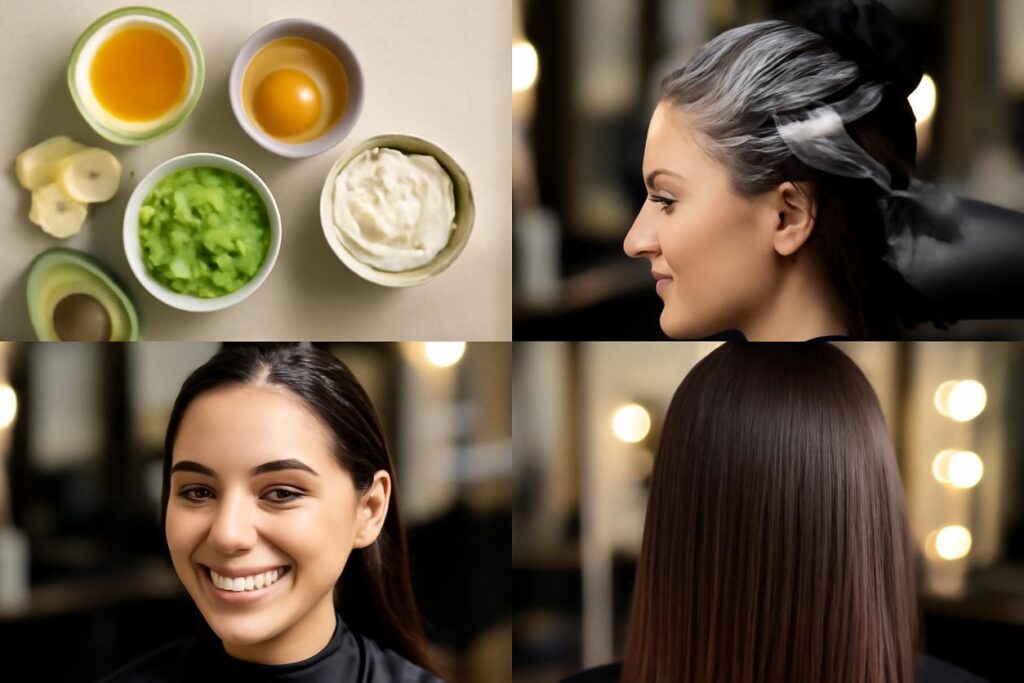The Ultimate Guide to Home Remedies for Hair Growth: Science, Recipes, and Your 2025 Plan
Table of Contents
- Introduction — How at-home care can influence hair growth
- The hair growth cycle explained (simple science)
- Key scalp and hair-supporting ingredients with evidence
- Scalp routines to promote a healthy growth environment
- Step-by-step DIY treatments and recipes
- Nutrition and lifestyle habits that support new growth
- Creating a personalised 8-week at-home plan
- Signs it is time to see a clinician
- Common questions and myths about natural hair growth
- Sources and further reading
Introduction — How at-home care can influence hair growth
Dreaming of longer, stronger, and healthier hair? You are not alone. While genetics play a significant role in hair thickness and growth rate, your daily habits and the care you provide can make a world of difference. The journey to luscious locks doesn’t always require expensive treatments. In fact, some of the most effective strategies can be found right in your kitchen. This guide explores the best home remedies for hair growth, blending traditional wisdom with modern scientific understanding.
The core principle behind successful at-home hair care is creating an optimal environment for your scalp and hair follicles. Think of your scalp as the garden and your hair as the plants. A well-nourished, clean, and stimulated garden will produce healthier, more resilient plants. By focusing on scalp health, proper nutrition, and targeted natural treatments, you can support your hair’s natural growth cycle, reduce breakage, and improve overall hair density and shine.
The hair growth cycle explained (simple science)
To understand how home remedies for hair growth work, it is helpful to know a little about how hair grows. Your hair goes through a continuous three-phase cycle. Supporting each phase is key to achieving your hair goals.
- Anagen (The Growing Phase): This is the active phase where hair follicles are pushing out hairs that will continue to grow. This phase can last anywhere from 2 to 7 years. The length of your anagen phase determines the maximum length your hair can reach.
- Catagen (The Transition Phase): A short, transitional phase lasting about 2 to 3 weeks. During this time, the hair follicle shrinks, and hair growth slows down.
- Telogen (The Resting Phase): The follicle is completely at rest, and the hair is shed. This phase lasts for about 3 months before a new anagen hair begins to grow in its place. It’s normal to shed 50 to 100 hairs a day as part of this natural cycle.
Effective natural remedies aim to prolong the anagen phase and ensure the follicles are healthy enough to produce strong new hairs.
Key scalp and hair-supporting ingredients with evidence
Nature provides a powerful toolkit for hair care. Here are some of the most researched and effective ingredients you can use in your home remedies for hair growth, along with the science behind them.
Coconut Oil: The Deep Conditioner
How it works: Coconut oil is rich in lauric acid, a type of fatty acid that has a low molecular weight, allowing it to penetrate the hair shaft more effectively than many other oils. This helps reduce protein loss from the hair, which is crucial for preventing damage and breakage. A well-moisturised, strong hair strand is less likely to snap, helping you retain length as it grows.
Safety notes: Choose virgin, cold-pressed coconut oil. If you have an oily scalp or fine hair, apply it primarily to the lengths and ends of your hair to avoid weighing it down. Always perform a patch test on your skin before a full application.
Rosemary: The Natural Stimulant
How it works: Rosemary, often used as an essential oil, is a star player in natural hair growth. It is believed to improve circulation to the scalp, ensuring that follicles get a rich supply of blood and nutrients. A notable study found that rosemary oil was as effective as 2% minoxidil (a common commercial hair growth treatment) for androgenetic alopecia after six months of use, but with less scalp itching. For more information on clinical studies, you can explore resources like PubMed.
Safety notes: Rosemary essential oil is potent and must be diluted with a carrier oil (like coconut, jojoba, or almond oil) before being applied to the scalp. A common ratio is 3-5 drops of rosemary oil per tablespoon of carrier oil.
Onion Juice: The Sulphur Powerhouse
How it works: While the smell might not be for everyone, onion juice is a traditional remedy backed by some promising science. It is high in dietary sulphur, a building block for keratin, the protein that makes up your hair. Sulphur may also help promote collagen production. Some small studies have suggested that applying onion juice to the scalp can help stimulate regrowth in cases of alopecia areata.
Safety notes: Onion juice can be irritating for some people. Always do a patch test first. To use, blend a small onion, strain the juice, and apply it to your scalp with a cotton pad for 15-30 minutes before washing thoroughly with shampoo.
Aloe Vera: The Soothing Healer
How it works: Aloe vera is known for its soothing and healing properties. It contains proteolytic enzymes that can help break down dead skin cells on the scalp, which can clog hair follicles. Its anti-inflammatory and antimicrobial properties help maintain a clean, balanced scalp environment. It is also incredibly hydrating for both the scalp and hair strands.
Safety notes: Use pure aloe vera gel, either directly from the plant or a store-bought version with no added alcohol or fragrances.
Castor Oil: The Rich Emollient
How it works: Castor oil is an extremely thick, rich oil packed with ricinoleic acid, a fatty acid known for its anti-inflammatory properties. While there is no direct scientific evidence that it makes hair grow faster, its intense moisturising capabilities can lubricate the hair shaft, increasing flexibility and decreasing the chance of breakage. This helps you retain the length you grow. It is a fantastic sealant for dry, brittle hair.
Safety notes: Due to its thickness, it can be difficult to apply and wash out. Mix it with a lighter oil like coconut or jojoba oil to improve its consistency. Use it sparingly, especially if you have fine hair.
Scalp routines to promote a healthy growth environment
A consistent routine is more important than any single ingredient. Incorporating these practices helps maximise the effectiveness of your home remedies for hair growth.
Scalp massage techniques and timing
A regular scalp massage is one of the simplest and most effective ways to encourage hair growth. It helps increase blood flow to the follicles, delivering more oxygen and nutrients essential for the anagen phase.
- Technique: Using the pads of your fingers (not your nails), apply gentle to medium pressure to your scalp. Move in small, circular motions across your entire head for 5-10 minutes daily.
- Timing: The best time to massage is right before you wash your hair. You can do it on a dry scalp or incorporate it with one of the DIY oil treatments mentioned below for a dual benefit.
Tools to use and what to avoid
Tools to Use:
- Silicone Scalp Massager: These handheld tools can help you apply even pressure and exfoliate the scalp gently without tangling your hair.
- Wide-Tooth Comb: Always use a wide-tooth comb to detangle your hair, especially when it is wet and at its most fragile. Start from the ends and work your way up to the roots.
What to Avoid:
- High Heat Styling: Excessive heat from straighteners, curling irons, and blow dryers can damage the hair’s protein structure, leading to weakness and breakage.
- Tight Hairstyles: Constant pulling from tight ponytails, buns, or braids can cause a type of hair loss called traction alopecia. Opt for looser styles whenever possible.
Step-by-step DIY treatments and recipes
Ready to get started? Here are three simple, effective DIY recipes using the ingredients we have discussed. These home remedies for hair growth are easy to make and can be adapted to your hair type.
Quick weekly mask for dry hair
This mask provides deep hydration and strength to prevent breakage.
- Ingredients: 2 tablespoons of virgin coconut oil, 1 tablespoon of pure aloe vera gel.
- Instructions: Gently warm the coconut oil until it is liquid but not hot. Mix in the aloe vera gel until smooth. Apply to your scalp and hair, focusing on the ends. Leave on for 30 minutes, then shampoo and condition as usual.
Lightweight serum for oily scalps
This stimulating serum helps balance the scalp without adding excess grease.
- Ingredients: 2 tablespoons of jojoba oil (a light oil that mimics natural sebum), 5 drops of rosemary essential oil.
- Instructions: Mix the rosemary oil into the jojoba oil. Using your fingertips or a dropper, apply a small amount directly to your scalp. Massage it in for 5 minutes. You can apply this 1-2 hours before washing or even leave it on overnight if your hair tolerates it.
Overnight repair pack for damaged hair
An intensive treatment to nourish and repair brittle, over-processed hair.
- Ingredients: 1 tablespoon of castor oil, 1 tablespoon of coconut oil.
- Instructions: Mix the two oils together. Warm them slightly for easier application. Carefully apply to the lengths and ends of your hair. Braid your hair loosely and cover it with a shower cap or silk scarf to protect your pillow. Wash it out thoroughly the next morning. You may need to shampoo twice.
Nutrition and lifestyle habits that support new growth
What you put inside your body is just as important as what you put on your hair. A balanced diet is a non-negotiable part of any plan for natural hair growth.
Top foods and supplements to discuss with a clinician
Your hair follicles require a steady supply of key nutrients to build strong, healthy hair. Ensure your diet is rich in the following:
- Protein: The building block of hair. Found in lean meats, fish, eggs, beans, and nuts.
- Iron: An iron deficiency (anaemia) is a major cause of hair loss. Sources include red meat, spinach, and lentils.
- Zinc: Important for hair tissue growth and repair. Found in oysters, beef, pumpkin seeds, and lentils.
- Biotin (Vitamin B7): A well-known vitamin for hair health. Sources include eggs, almonds, and sweet potatoes.
- Vitamin C: Helps your body absorb iron and create collagen. Abundant in citrus fruits, bell peppers, and strawberries.
Before starting any supplements, it is crucial to speak with a healthcare provider. They can perform blood tests to check for deficiencies and recommend the appropriate dosage. For reliable health information, consult resources like the NHS.
Creating a personalised 8-week at-home plan for 2025
Consistency is key. Here is a sample 8-week plan to integrate these home remedies for hair growth into your routine. Remember, hair growth is slow, so patience is essential!
| Activity | Frequency | Goal |
|---|---|---|
| Scalp Massage | Daily (5 minutes) | Stimulate blood flow |
| Weekly Treatment | Once per week | Nourish and strengthen |
| Gentle Detangling | As needed | Prevent breakage |
| Balanced Diet | Daily | Provide essential nutrients |
Adjustments by hair type: fine, curly, textured, oily
- Fine Hair: Use lighter oils like jojoba or almond oil. Apply treatments primarily to the ends to avoid weighing down the roots. Do not leave treatments on overnight.
- Curly and Textured Hair: Your hair may love richer treatments. You can use the overnight repair pack more frequently. Focus on sealing in moisture to prevent breakage along the coils and curls. We recommend great insights from Rich Hair UK for textured hair care.
- Oily Hair: Focus on scalp-clarifying ingredients like aloe vera and rosemary. The lightweight serum is your best friend. Avoid applying heavy oils directly to the scalp.
Signs it is time to see a clinician
While home remedies for hair growth are excellent for supporting overall hair health, they cannot treat underlying medical conditions. Please consult a doctor or dermatologist if you experience:
- Sudden or patchy hair loss.
- An unusual amount of shedding (more than 150 hairs per day).
- A painful, itchy, or scaly scalp.
- Hair loss accompanied by other symptoms like fatigue or weight changes.
The American Academy of Dermatology offers a wealth of professional advice on hair loss conditions.
Common questions and myths about natural hair growth
Myth: Trimming your hair makes it grow faster.
Fact: Hair grows from the scalp, so trimming the ends has no effect on the rate of growth. However, regular trims (every 8-12 weeks) are crucial for removing split ends, which prevents breakage and helps you retain length, making hair appear to grow faster and healthier.
Question: Can I make my hair grow overnight?
Answer: Unfortunately, no. Healthy hair grows about half an inch per month on average. There is no magic potion for instant growth. The key is a consistent, long-term approach to scalp health and damage prevention.
Myth: You have to wash your hair every day for it to be healthy.
Fact: Over-washing can strip your scalp and hair of its natural, protective oils, leading to dryness and breakage. How often you should wash depends on your hair type. Oily hair may need more frequent washing, while dry or curly hair may benefit from washing only a couple of times a week.
Sources and further reading
This guide is for informational purposes only. For medical advice and diagnosis, always consult a qualified healthcare professional. For further reading on hair health and scientific studies, please visit the resources linked throughout this article.





